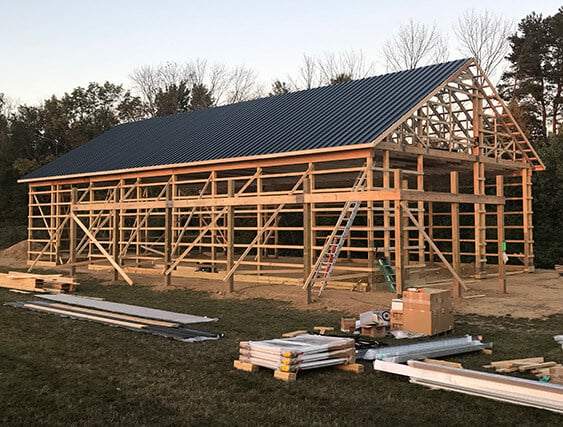Post-Frame vs. Studwork-Framed Buildings: Which One is Right for You?
When considering a construction project, whether it’s a timber agricultural barn, a timber frame shed, or a bespoke timber frame house, the choice of building method plays a crucial role in durability, cost, and functionality. Two of the most common methods are post-frame buildings and studwork-framed buildings. Understanding their differences will help you make an informed decision when investing in timber barns and buildings or other timber structures.
What is a Post-Frame Building?
A post-frame building, often referred to as a pole barn, is a construction technique that utilizes large timber posts or poles embedded in the ground or anchored to a concrete pier. These posts support the entire structure, allowing for open interior spaces without the need for load-bearing walls. This makes post-frame timber agricultural barns highly versatile and cost-effective.
Key Features of Post-Frame Construction:
-
Structural Support: Large wooden posts transfer weight directly into the ground, reducing the need for extensive foundations.
-
Wider Spacing: Posts are spaced 8 to 12 feet apart, allowing for fewer materials and faster construction.
-
Flexible Interior Layout: No need for internal load-bearing walls, making it ideal for timber barns kits, garages, and workshops.
-
Foundation Options: Can be built directly into the ground or on concrete piers, reducing foundation costs.
-
Cost-Effective: Requires fewer materials and labor compared to traditional timber frame buildings.
Best Uses for Post-Frame Buildings:
-
Timber agricultural barns UK
-
Wooden agricultural barns
-
Large garages and workshops
-
Horse stables and riding arenas
-
Storage sheds and warehouses
What is a Studwork-Framed Building?
A studwork-framed building, often referred to as a stick-built structure, is a traditional method using vertical wooden studs spaced 16 to 24 inches apart. These walls are then sheathed with plywood or OSB for added strength, creating a solid and insulated structure. This method is commonly used in bespoke timber frame houses and insulated timber outbuildings UK.
Key Features of Studwork Construction:
-
Load-Bearing Walls: The entire wall system distributes the weight, requiring a solid foundation.
-
Narrow Stud Spacing: Studs are placed closer together, usually 16-24 inches apart, making walls more rigid.
-
Highly Insulated: Ideal for bespoke timber frame buildings used as homes, offices, or heated workshops.
-
Requires a Full Foundation: Typically built on a concrete slab or full foundation, increasing costs but enhancing durability.
Best Uses for Studwork-Framed Buildings:
-
Bespoke timber frame houses
-
Insulated home offices and guest houses
-
Timber barns for sale that require insulation
-
Garden rooms and hobby spaces
Post-Frame vs. Studwork: Which One to Choose?
| Feature | Post-Frame Building | Studwork-Framed Building |
|---|---|---|
| Structural Support | Large posts in ground | Vertical studs on foundation |
| Spacing | 8-12 feet apart | 16-24 inches apart |
| Foundation | Concrete piers or in-ground | Full concrete foundation |
| Speed of Construction | Faster, fewer materials | Slower, more materials |
| Cost | Generally lower | Generally higher |
| Best For | Open spaces, barns, garages | Homes, insulated buildings |
Can I Build a Barn on Agricultural Land?
If you are considering constructing a timber agricultural barn, you may be wondering, “Can I build a barn on agricultural land?” The answer depends on local planning laws in the UK. In many cases, permitted development rights allow for the construction of timber agricultural barns and sheds without full planning permission, provided they are used for genuine agricultural purposes.
However, if you plan to use a timber agricultural barn for residential or commercial activities, you may need to apply for additional planning permissions. Always consult your local planning authority before proceeding with your build.
Finding the Right Timber Barn Kits for Your Needs
When choosing a timber barn kit or timber agricultural barn for sale, consider factors such as size, insulation, and intended use. Timber barns for sale come in a variety of styles, from simple storage sheds to large-scale timber agricultural barns UK designed for livestock, equipment storage, or workspace.
Conclusion
Whether you choose post-frame or studwork-framed construction depends on your specific needs. If you require a cost-effective, spacious, and quick-to-build structure, post-frame buildings are an excellent choice for timber agricultural barns and sheds. However, if you need a highly insulated, structurally dense building, studwork-framed buildings are better suited for bespoke timber frame buildings and bespoke timber frame houses.
For those looking for timber frame sheds for sale or custom timber outbuildings in the UK, it’s essential to work with a trusted supplier to ensure quality craftsmanship and compliance with UK building regulations. If you need help selecting the right timber barns and buildings for your project, get in touch with an expert today!


 Back
Back
 February 18, 2025
February 18, 2025  4 min read
4 min read




